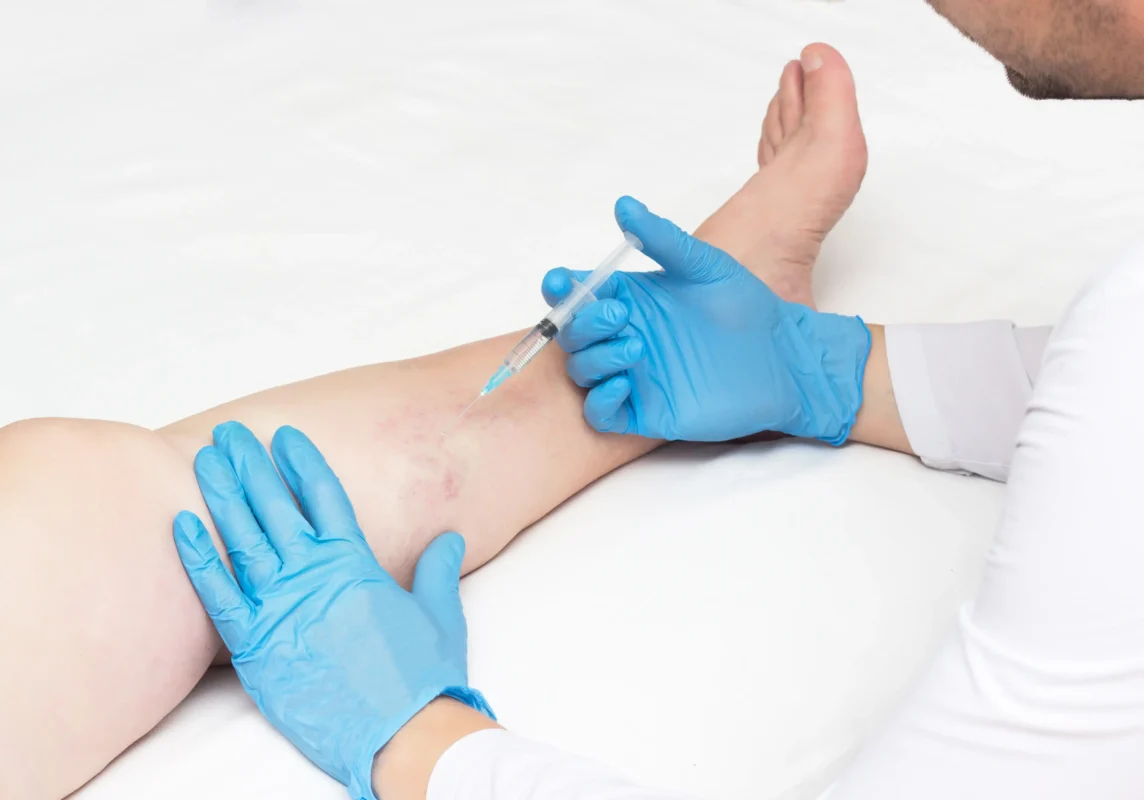Getting sclerotherapy treatment near you removes your spider veins – for good
If you look search for ‘how to get rid of spider veins’, the internet offers lots of different advice – using compression stockings, or home remedies such as essential oils or apple cider vinegar, and more. The bottom line is – none of this works. Sclerotherapy is a minimally invasive solution that can permanently get rid of your spider veins.
In sclerotherapy, vein doctors inject a medicated solution (called sclerosant) directly into the spider veins. The solution makes the vein walls stick together and seal off. Over the next three to four weeks, your body reacts to this non-functional vein, and digests it completely. So the original vein completely disappears, permanently solving the problem.
The sclerotherapy procedure is quick and painless
This is a minimally invasive procedure, and does not require blood tests, hospital admissions, or long appointments. You can get this done in less than an hour at the doctor’s office – it is similar to having a dental filling! The needles used for the injections are very, very tiny, and the prick barely causes any discomfort. Sclerotherapy requires no downtime – you can get back to your regular schedule right after the procedure.

In the long run, it is more economical than the average cost of laser spider vein treatment
Some people prefer to go for laser treatment as an alternative spider vein treatment. A single session costs lesser than a single session of sclerotherapy, and it is non-invasive – the laser light is beamed on to the skin over the spider veins. However, to get the same results as sclerotherapy, one laser session is not enough – you will need at least three to four sittings to completely eliminate the spider veins. So in the long run, you end up paying more for laser than you would for sclerotherapy. Moreover, when you go to an experienced vein doctor, the tiny needle prick used in sclerotherapy is hardly felt – so this may actually be as painless as laser treatment.
Tanning after sclerotherapy: How much should you worry?
It is natural to be concerned about the after-effects of sclerotherapy. The most common concern is skin tanning after the procedure. The skin over the spider vein is prone to hyperpigmentation after sclerotherapy, especially if you tend to tan easily. This can easily be avoided if you take due precautions. Use a medicated sunscreen with SPF60 for at least six weeks after sclerotherapy. You should also avoid direct sunlight for up to three weeks after the procedure.
You may also experience mild pain or bruising after the procedure. Your vein doctor will prescribe pain medication to deal with this. You will also need to wear compression stockings for one to three weeks after treatment. This reduces swelling and bruising, and helps in faster healing.

Sclerotherapy will not get rid of painful symptoms, if you have any
Scleotherapy is essentially a cosmetic procedure. However, some people with spider veins can also experience painful symptoms – such as swollen ankles, heavy, aching feet and throbbing pain in the legs. In these cases, your spider veins have formed as a result of another vein condition, called chronic venous insufficiency (CVS).
In CVS, the main leg vein is diseased. Its fails to return blood back to the heart in an efficient manner. As a result, excess blood pools in the leg veins, and this causes the pressure in the leg veins to increase. Under the excess pressure, blood may be forced out into newer, unhealthy veins. If these new veins are small, they appear as purplish streaks within the skin, and are called spider veins. If these veins are large, they appear as twisted, rope like structures, called varicose veins. So if you have painful symptoms, it is quite likely that you have CVS – and may have varicose veins as well.
So, will you also need varicose vein removal treatment, or other vein treatment procedures?
If you do have symptoms of vein disease, then yes, you will most probably need additional treatment procedures. Treating your spider veins is only the tip of the iceberg – you will want to take care of what lies underneath as well!For CVS and varicose veins treatments, the main leg vein that is diseased needs to be shut down. Once this vein is sealed off completely, the blood re-routes to the heart through other healthier veins, and the transport system once again becomes efficient. To seal off the main vein, vein doctors commonly employ one of the following minimally invasive procedures:
- Radiofrequency ablation: Uses heat energy to seal off the vein from within.
- Endovenous laser ablation: Uses laser energy to seal the vein from within.
- VenaSeal: Medicated glue blocks up the vein
- Clarivein: Sclerosant is dispersed throughout the vein using a tiny, rotating catheter
- Varithena: Uses foam sclerosant that can naturally disperse across medium sized veins.
The Vein Treatment Clinic offers state of the art treatment for spider veins, as well as varicose veins and CVS. At VTC, our team of board certified physicians will put together a customized treatment plan for you, depending on the kind of vein conditions you have. To consult with our expert vein doctors, book an appointment online, or call (844) 690-1788.







